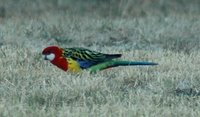
OK, I know it is a bit weird to have favourite tree trunks, but bear with me.
The Botanic Gardens (ANBG) is housed within a natural forest, (see photo at left) of mixed Eucalyptus tree species. In simple terms they are smooth barked "gum" trees and rough barked, "stringybarks". They look completely different, but they are all related - part of a huge and varied genus of plants.
Please don't try and tie me up with the details of the species, (I am not a specialist). There are a many endemic (local, natually occurring) species on Black Mountain, the site of these Gardens, in Canberra. But in reality, the dominant species are probably only 4 or 5 in number. Over the last 57 years, hundreds of other Australian Eucalypt species have been plants throughout the Gardens (they were not officially opened till 1967 - see this link for the chronology of the Gardens).
 But my favourite trees are the really old, gnarled natural trees, especially this huge old "Brittle Gum" - (Eucalyptus maculata).
But my favourite trees are the really old, gnarled natural trees, especially this huge old "Brittle Gum" - (Eucalyptus maculata).
It is about 20 metres tall, and close to 35 metres wide. To me, it is the treasure of the Gardens. And it is simply an old tree, growing where it always has done so.
This particular tree has been shaped by the forces of nature. It is also a favourite with kids, and its bark has been rubbed smooth, low down, where thousands of kids have "patted" this tree. I like that kids "relate" to Nature in this way. Technically, they are not allowed to, but the guides and explainers never really seem to manage to see it happening!
The tree's trunk has been been split, probably by lightning, at some stage after it had matured. This is not clearly visible in this photo - the  damage is at the far side of the base of the trunk. but, the whole tree is out of balance, and it must have leaned over at some satage, till it propped itself up with its lower branches.
damage is at the far side of the base of the trunk. but, the whole tree is out of balance, and it must have leaned over at some satage, till it propped itself up with its lower branches.
I would acknowledge that the tree has shaped and modified by "arborists" - in the interest of "public liability", etc, no doubt. In fact, they have removed most of those branches which were once propping up the tilted tree. But it is surviving well.But it beauty is entirely Natural.
Many of these trees have remarkable individual variation between them, in shape and colouration of bark.
 When I was volunteering here, as a guide, I was frequently asked by North American visitors, (especially) why our trees were "naked". To people familiar with Pines, Elms, Oaks, etc they obviously seems that way.
When I was volunteering here, as a guide, I was frequently asked by North American visitors, (especially) why our trees were "naked". To people familiar with Pines, Elms, Oaks, etc they obviously seems that way.
In fact these smooth barked "gums" (and some of the related "Angopheras") shed their "outer bark" on an annual basis. The bark tends to fall away in smallish chunks, and the new bark (underneath) is often stained or coloured for a time (see next photo), before resuming the more normal white, silvery or pink colouration.
Here is another of my favourite trees - a classic tall, open specimen, in an area of lawn known as the Eucalypt Lawn. This area is very popular with visitors for summer picnics, and concerts are often held in this area, over the summer.
 And now for something mischievous! I call this photo the "old man's pyjamas". Of course I have posted this photo upside down. The tree is growing normally. But the stained colour is completely natural.
And now for something mischievous! I call this photo the "old man's pyjamas". Of course I have posted this photo upside down. The tree is growing normally. But the stained colour is completely natural.
Kindly allow me one little visual joke!
I decided to do this today, to allow my mind some relaxation from the Chemotherapy treatment I started this morning. Everything is fine, so far.
*****
Thanks for the emailed wishes of support, especially from my friends at Robertson. I really value that friendly aspect of the Nature Of Robertson. It is a small township, a village, really, but the size of the settlement allows people to get to know eachother, through casual meeting at the Supermarket, at the Newsagency, at Churches, or, my favourite meeting place, the CTC.
Our society has lost so much through the formation of huge, anonymous cities. I believe the scale of villages suits humans better.



















 Their eye colour (the iris) is dark red as shown in Photo 3, (left). But they have pinkish skin around their eyes, and when displaying they somehow make their eyes bulge, and the skin around the eye gets enlarged, making the apparent eye size nearly treble the actual size of the eye. It is quite an effective display technique, even if it makes them appear stranger than normal to this human observer.
Their eye colour (the iris) is dark red as shown in Photo 3, (left). But they have pinkish skin around their eyes, and when displaying they somehow make their eyes bulge, and the skin around the eye gets enlarged, making the apparent eye size nearly treble the actual size of the eye. It is quite an effective display technique, even if it makes them appear stranger than normal to this human observer.






















